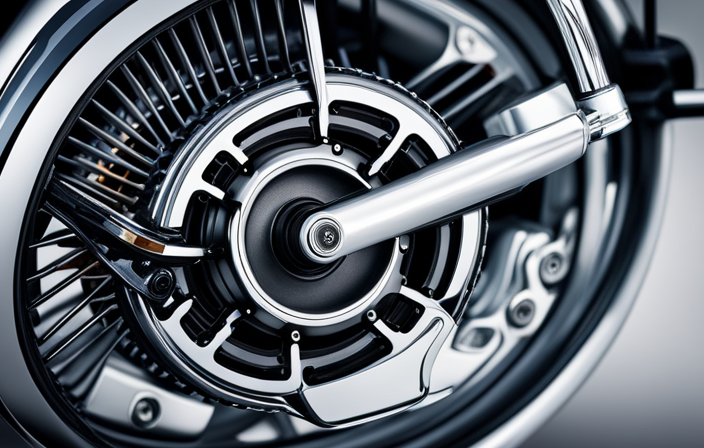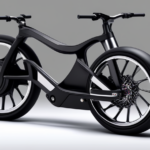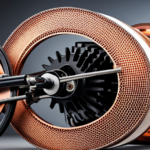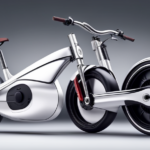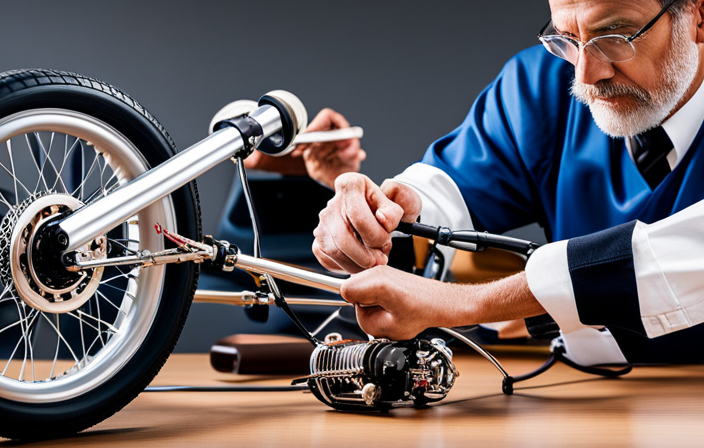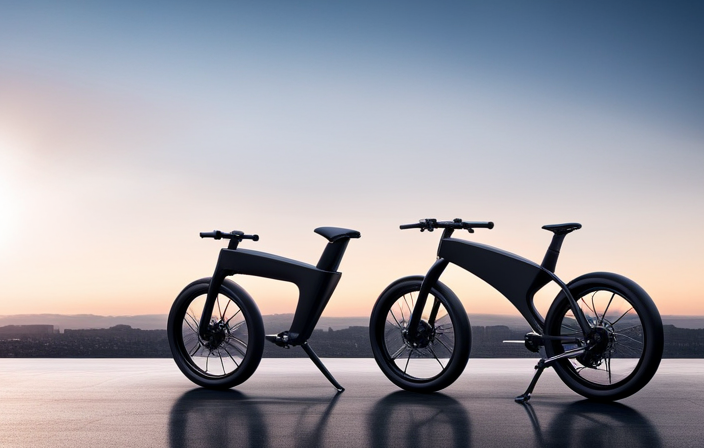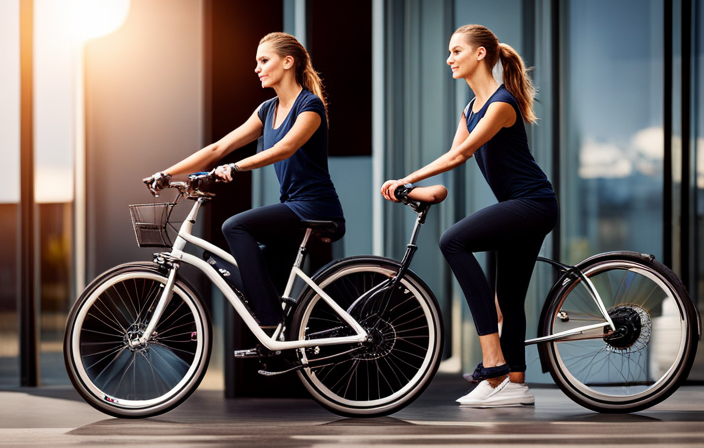Prepare yourself for an adventure on the open road with the strength of an electric bicycle.
But before you embark on your two-wheeled adventure, it’s important to understand just how long those motors can last. Like the beating heart of your bike, these motors are the key to your smooth and effortless ride.
In this article, we’ll delve into the world of electric bike motors, exploring their average lifespan, factors that affect their longevity, and tips for keeping them going strong.
So buckle up and let’s rev up the engine of knowledge!
Key Takeaways
- Electric bike motors have long-lasting durability, providing reliable and consistent performance.
- These motors require less maintenance and repair costs, saving time and money in the long run.
- Long-lasting motors are efficient for navigating hilly terrains and achieving high speeds, making them suitable for various biking adventures.
- Investing in a long-lasting motor ensures a reliable and enjoyable biking experience for years to come, whether for commuting or leisure biking.
Understanding Electric Bike Motors
Electric bike motors typically last for several thousand miles of riding. Motor efficiency plays a crucial role in determining the lifespan of an electric bike motor. Higher efficiency motors tend to have a longer lifespan as they generate less heat and put less strain on the internal components.
Regular motor maintenance is also essential to prolong its lifespan. This includes keeping the motor clean and ensuring proper lubrication of its moving parts. Additionally, checking and tightening any loose connections or bolts can help prevent unnecessary wear and tear.
Factors such as rider weight, terrain, and riding style can also affect the lifespan of the motor. By considering motor efficiency and performing regular maintenance, you can extend the lifespan of your electric bike motor and enjoy many miles of smooth and reliable riding.
Factors Affecting Motor Lifespan
To maximize the lifespan of your electric bike motor, it’s important to consider various factors. Proper motor maintenance plays a crucial role in ensuring its longevity. Regularly cleaning and lubricating the motor can prevent dust and debris from causing damage. Additionally, you should check the motor’s connections and wiring for any signs of wear or corrosion.
It’s also important to avoid overloading the motor by carrying excessive weight or constantly riding at maximum speed. Common motor issues include overheating, which can be caused by prolonged use without breaks or riding in extreme weather conditions. By addressing these factors and performing regular maintenance, you can significantly extend the lifespan of your electric bike motor.
Transitioning into the subsequent section about the average lifespan of electric bike motors, it’s important to note that understanding these factors will give you a better idea of how long your motor is likely to last.
Average Lifespan of Electric Bike Motors
On average, electric bike motors have a lifespan that can be extended with proper maintenance and consideration of various factors. Taking care of your electric bike motor is crucial to ensure its longevity. Here are four important factors to keep in mind:
-
Regular maintenance: Like any other mechanical device, electric bike motors require regular maintenance. This includes cleaning, lubricating, and inspecting the motor components.
-
Avoiding overheating: Overheating can significantly reduce the lifespan of an electric bike motor. Make sure to monitor the motor temperature and avoid extended periods of high power usage.
-
Battery care: The battery is an integral part of the electric bike motor system. Properly maintaining and charging the battery can help prolong the motor’s lifespan.
-
Recognizing signs of wear: Keep an eye out for any unusual noises, vibrations, or decreased performance. These may be signs of motor wear that need to be addressed promptly.
By following these maintenance practices, you can significantly extend the lifespan of your electric bike motor.
Now, let’s move on to some tips for further increasing its longevity.
Tips for Extending Motor Lifespan
One way to increase the lifespan of your e-bike motor is by implementing proper maintenance practices. Regular maintenance is essential to ensure that your motor operates at its optimal performance level.
First, make sure to keep your motor clean and free from debris, as dirt and grime can cause damage over time. Additionally, regularly inspect the motor for any signs of wear or damage, such as frayed wires or loose connections. If you notice any issues, address them promptly to avoid further damage.
Troubleshooting common motor issues, such as unusual noises or decreased power output, can also help extend the motor’s lifespan. By following these maintenance tips and promptly addressing any issues, you can enjoy your e-bike motor for an extended period of time.
Moving forward, let’s discuss the next section about replacing electric bike motors.
Replacing Electric Bike Motors
If you find that your electric bike motor is no longer performing as it should, there are a few key points to consider when it comes to replacing it.
Firstly, you should consider motor replacement when your current motor is beyond repair or the cost of repairing it outweighs the cost of a new motor.
Secondly, cost considerations should be taken into account, as replacing an electric bike motor can be a significant investment.
Lastly, if you are looking to upgrade to a more powerful motor for increased speed or better performance, motor replacement can be a great option.
When to consider motor replacement
When to consider replacing the motor in an electric bike is an important question to address. Proper motor maintenance is crucial to ensure the longevity of your electric bike. However, there may come a time when motor failure becomes inevitable. Here are some signs to look out for that indicate it may be time to replace your electric bike motor:
- Decreased power output: If you notice a significant decline in the power and speed of your electric bike, it could be a sign of motor failure.
- Unusual noises: Strange grinding or clunking sounds coming from the motor can indicate internal damage.
- Overheating: If your motor is constantly overheating, it may be a sign of a malfunctioning component.
- Frequent breakdowns: If your motor is constantly breaking down and requiring repairs, it may be more cost-effective to replace it.
Considering these signs, it is important to evaluate the cost considerations of motor replacement.
Cost considerations
To determine whether it’s financially feasible to replace the motor in your electric bike, you should take into account the cost of the new motor and the potential savings from avoiding frequent repairs.
Electric bike motor maintenance plays a crucial role in determining its lifespan. It is important to understand that the quality of the motor greatly impacts its durability. A well-maintained high-quality motor can last up to 10,000 miles or more, while a lower-quality motor might only last half as long.
Regularly cleaning and lubricating the motor, as well as keeping it protected from harsh weather conditions, can significantly extend its lifespan. By investing in a reliable, high-quality motor and properly maintaining it, you can avoid the hassle and expenses of frequent repairs.
This will also allow you to consider upgrading to a more powerful motor for enhanced performance and increased range.
Upgrading to a more powerful motor
Upgrading to a more powerful motor can enhance performance and increase range on your electric bike. When considering an upgrade, it is important to take motor maintenance into account. A more powerful motor may require additional maintenance to ensure optimal performance and longevity.
Regular maintenance tasks such as lubricating the motor and inspecting the wiring connections should be performed to keep the motor running smoothly. Additionally, choosing the right motor for your specific needs is crucial. Factors such as terrain, weight, and desired speed should be considered when selecting a more powerful motor. It is recommended to consult with experts or do thorough research to find the motor that best suits your requirements.
By upgrading to a more powerful motor and properly maintaining it, you can enjoy improved performance and extended range on your electric bike.
This leads us to the subsequent section, discussing the benefits of long-lasting electric bike motors.
Benefits of Long-lasting Electric Bike Motors
You’ll love the benefits of electric bike motors that last a long time.
One of the key advantages of long-lasting electric bike motors is their durability. These motors are built to withstand the test of time, allowing you to enjoy your electric bike for years to come without worrying about motor failure. The durability of these motors ensures a reliable and consistent performance, whether you’re commuting to work or going on long rides.
Additionally, a long-lasting motor means less maintenance and repair costs in the long run, saving you time and money. You can trust that your electric bike will continue to provide efficient power, allowing you to effortlessly navigate hilly terrains or cruise along at high speeds.
Invest in an electric bike with a motor that lasts, and experience the many benefits it brings to your biking adventures.
Frequently Asked Questions
Are electric bike motors covered under warranty?
Yes, electric bike motors are commonly covered under warranty. This provides protection against any potential issues that may arise with the motor. Common issues with electric bike motors include overheating, motor failure, and electrical malfunctions.
Can I repair or replace individual components of an electric bike motor?
Yes, you can repair or replace individual components of an electric bike motor. This allows you to fix any specific issues that may arise, ensuring the motor continues to function optimally.
Are there any specific maintenance requirements for electric bike motors?
Maintaining electric bike motors involves best practices and avoiding common mistakes. Look out for common signs of motor wear and tear, such as unusual noises or decreased performance. Address these issues promptly to ensure optimal motor function.
How does the type of terrain affect the lifespan of electric bike motors?
Motor efficiency on different terrains varies due to factors like resistance and elevation changes. Steep inclines can put additional strain on the motor, potentially shortening its lifespan. Regular maintenance and proper usage can help mitigate these effects.
Can I upgrade the motor on my electric bike to improve performance or extend its lifespan?
Yes, you can upgrade the motor on your electric bike to improve performance and extend its lifespan. By upgrading the motor, you can enhance its power output, efficiency, and durability, resulting in better overall motor performance.
Conclusion
So there you have it, my friend! Electric bike motors are like the Energizer bunny on steroids – they just keep going and going!
With proper care and maintenance, these bad boys can last you a lifetime.
So go ahead and ride that electric bike with confidence, knowing that your trusty motor will never let you down.
And hey, if you ever need to replace it, don’t worry! There are plenty of long-lasting options out there.
Keep on riding, and may your electric bike motor continue to defy the laws of time!
